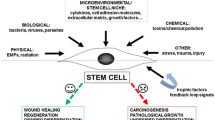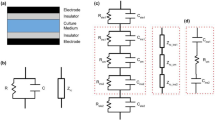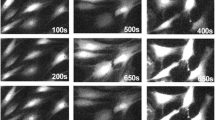Abstract
The purpose of this study was to develop a new apparatus for in vitro studies applying low frequency electrical fields to cells without interfering side effects like biochemical reactions or magnetic fields which occur in currently available systems. We developed a non-invasive method by means of the principle of transformer-like coupling where the magnetic field is concentrated in a toroid and, therefore, does not affect the cell culture. Next to an extensive characterization of the electrical field parameters, initial cell culture studies have focused on examining the response of bone marrow-derived human mesenchymal stem cells (MSCs) to pulsed electrical fields. While no significant differences in the proliferation of human MSCs could be detected, significant increases in ALP activity as well as in gene expression of other osteogenic markers were observed. The results indicate that transformer-like coupled electrical fields can be used to influence osteogenic differentiation of human MSCs in vitro and can pose a useful tool in understanding the influence of electrical fields on the cellular and molecular level.



Similar content being viewed by others
References
Roux, W. (1885). Beitrag zur Morphologie der funktionellen Anpassung. Archives d’Anatomie et de Cytologie Pathologiques, 9, 120–158.
Wolff, J. (1892). Das Gesetz der Transformation von Knochen. Berlin: Verlag von August Hirschwald.
Prince, R. L., Smith, M., Dick, I. M., Price, R. I., Webb, P. G., Henderson, N. K., et al. (1991). Prevention of postmenopausal osteoporosis. A comparative study of exercise, calcium supplementation, and hormone-replacement therapy. New England Journal of Medicine, 325, 1189–1195.
Bassey, E. J., & Ramsdale, S. J. (1994). Increase in femoral bone density in young women following high-impact exercise. Osteoporosis International, 4, 72–75.
Morey, E. R., & Baylink, D. J. (1978). Inhibition of bone formation during space flight. Science, 201, 1138–1141.
Rambaut, P. C., & Goode, A. W. (1985). Skeletal changes during space flight. Lancet, 2, 1050–1052.
Fukada, E., & Yasuda, I. (1957). On the piezoelectric effect of bone. Journal of the Physical Society of Japan, 12, 121–128.
Bassett, C. A. (1968). Biologic significance of piezoelectricity. Calcified Tissue Research, 1, 252–272.
Friedenberg, Z. B., & Brighton, C. T. (1966). Bioelectric potentials in bone. Journal of Bone and Joint Surgery. American Volume, 48, 915–923.
Brighton, C. T., Black, J., Friedenberg, Z. B., Esterhai, J. L., Day, L. J., & Connolly, J. F. (1981). A multicenter study of the treatment of non-union with constant direct current. Journal of Bone and Joint Surgery. American Volume, 63, 2–13.
Paterson, D. (1984). Treatment of nonunion with a constant direct current: A totally implantable system. Orthopedic Clinics of North America, 15, 47–59.
Brighton, C., & Pollack, S. (1985). Treatment of recalcitrant non-union with a capacitively coupled electrical field. A preliminary report. Journal of Bone and Joint Surgery. American Volume, 67, 577–585.
Goodwin, C. B., Brighton, C. T., Guyer, R. D., Johnson, J. R., Light, K. I., & Yuan, H. A. (1999). A double-blind study of capacitively coupled electrical stimulation as an adjunct to lumbar spinal fusions. Spine (Phila Pa 1976), 24, 1349–1356; discussion 1357.
Bassett, C. A., Mitchell, S. N., & Gaston, S. R. (1981). Treatment of ununited tibial diaphyseal fractures with pulsing electromagnetic fields. Journal of Bone and Joint Surgery. American Volume, 63, 511–523.
Chang, W. H., Hwang, I. M., & Liu, H. C. (1991). Enhancement of fracture healing by specific pulsed capacitively-coupled electric field stimulation. Frontiers of Medical and Biological Engineering, 3, 57–64.
Ciombor, D. M., & Aaron, R. K. (1993). Influence of electromagnetic fields on endochondral bone formation. Journal of Cellular Biochemistry, 52, 37–41.
Black, J. (1987). Electrical stimulation—its role in growth, repair, and remodeling of the musculoskeletal system. New York: Praeger.
Supronowicz, P. R., Ajayan, P. M., Ullmann, K. R., Arulanandam, B. P., Metzger, D. W., & Bizios, R. (2002). Novel current-conducting composite substrates for exposing osteoblasts to alternating current stimulation. Journal of Biomedical Materials Research, 59, 499–506.
Midura, R. J., Ibiwoye, M. O., Powell, K. A., Sakai, Y., Doehring, T., Grabiner, M. D., et al. (2005). Pulsed electromagnetic field treatments enhance the healing of fibular osteotomies. The Journal of Orthopaedic Research, 23, 1035–1046.
Fini, M., Cadossi, R., Canè, V., Cavani, F., Giavaresi, G., Krajewski, A., et al. (2002). The effect of pulsed electromagnetic fields on the osteointegration of hydroxyapatite implants in cancellous bone: A morphologic and microstructural in vivo study. The Journal of Orthopaedic Research, 20, 756–763.
Jansen, J. H. W., van der Jagt, O. P., Punt, B. J., Verhaar, J. A. N., van Leeuwen, J. P. T. M., Weinans, H., et al. (2010). Stimulation of osteogenic differentiation in human osteoprogenitor cells by pulsed electromagnetic fields: An in vitro study. BMC Musculoskeletal Disorders, 11, 188.
Sun, L.-Y., Hsieh, D.-K., Lin, P.-C., Chiu, H.-T., & Chiou, T.-W. (2010). Pulsed electromagnetic fields accelerate proliferation and osteogenic gene expression in human bone marrow mesenchymal stem cells during osteogenic differentiation. Bioelectromagnetics, 31, 209–219.
Tsai, M.-T., Li, W.-J., Tuan, R. S., & Chang, W. H. (2009). Modulation of osteogenesis in human mesenchymal stem cells by specific pulsed electromagnetic field stimulation. The Journal of Orthopaedic Research, 27, 1169–1174.
Sollazzo, V., Palmieri, A., Pezzetti, F., Massari, L., & Carinci, F. (2010). Effects of pulsed electromagnetic fields on human osteoblastlike cells (mg-63): A pilot study. Clinical Orthopaedics and Related Research, 468, 2260–2277.
Aaron, R. K., Ciombor, D. M., & Simon, B. J. (2004). Treatment of nonunions with electric and electromagnetic fields. Clinical Orthopaedics and Related Research, 419, 21–29.
Chang, K., Chang, W. H.-S., Wu, M.-L., & Shih, C. (2003). Effects of different intensities of extremely low frequency pulsed electromagnetic fields on formation of osteoclast-like cells. Bioelectromagnetics, 24, 431–439.
Heermeier, K., Spanner, M., Träger, J., Gradinger, R., Strauss, P. G., Kraus, W., et al. (1998). Effects of extremely low frequency electromagnetic field (EMF) on collagen type I mRNA expression and extracellular matrix synthesis of human osteoblastic cells. Bioelectromagnetics, 19, 222–231.
Haddad, J. B., Obolensky, A. G., & Shinnick, P. (2007). The biologic effects and the therapeutic mechanism of action of electric and electromagnetic field stimulation on bone and cartilage: New findings and a review of earlier work. The Journal of Alternative and Complementary Medicine, 13, 485–490.
Verfahren und Vorrichtung zur Einkopplung eines elektrischen Feldes in ein physiologisches und elektrisch leitfähiges Medium. DE Patent 102006015550 B4, 2006.
Rentsch, B., Hofmann, A., Breier, A., Rentsch, C., & Scharnweber, D. (2009). Embroidered and surface modified polycaprolactone-co-lactide scaffolds as bone substitute: In vitro characterization. Annals of Biomedical Engineering, 37, 2118–2128.
Oswald, J., Boxberger, S., Jørgensen, B., Feldmann, S., Ehninger, G., Bornhäuser, M., et al. (2004). Mesenchymal stem cells can be differentiated into endothelial cells in vitro. Stem Cells, 22, 377–384.
Wollenweber, M., Domaschke, H., Hanke, T., Boxberger, S., Schmack, G., Gliesche, K., et al. (2006). Mimicked bioartificial matrix containing chondroitin sulphate on a textile scaffold of poly(3-hydroxybutyrate) alters the differentiation of adult human mesenchymal stem cells. Tissue Engineering, 12, 345–359.
Livak, K. J., & Schmittgen, T. D. (2001). Analysis of relative gene expression data using real-time quantitative pcr and the 2(−delta delta c(t)) method. Methods, 25, 402–408.
Lunze, K. (1991). Einführung in die Elektrotechnik (13th ed.). Berlin: Verlag Technik.
Aaron, R. K., & Ciombor, D. M. (1996). Acceleration of experimental endochondral ossification by biophysical stimulation of the progenitor cell pool. The Journal of Orthopaedic Research, 14, 582–589.
Schwartz, Z., Simon, B. J., Duran, M. A., Barabino, G., Chaudhri, R., & Boyan, B. D. (2008). Pulsed electromagnetic fields enhance BMP-2 dependent osteoblastic differentiation of human mesenchymal stem cells. The Journal of Orthopaedic Research, 26, 1250–1255.
Esposito, M., Lucariello, A., Riccio, I., Riccio, V., Esposito, V., & Riccardi, G. (2012). Differentiation of human osteoprogenitor cells increases after treatment with pulsed electromagnetic fields. In vivo, 26, 299–304.
Hammerick, K. E., James, A. W., Huang, Z., Prinz, F. B., & Longaker, M. T. (2010). Pulsed direct current electric fields enhance osteogenesis in adipose-derived stromal cells. Tissue Engineering Part A, 16, 917–931.
Hronik-Tupaj, M., Rice, W. L., Cronin-Golomb, M., Kaplan, D. L., & Georgakoudi, I. (2011). Osteoblastic differentiation and stress response of human mesenchymal stem cells exposed to alternating current electric fields. Biomedical Engineering Online, 10, 9.
Kim, I. S., Song, J. K., Song, Y. M., Cho, T. H., Lee, T. H., Lim, S. S., et al. (2009). Novel effect of biphasic electric current on in vitro osteogenesis and cytokine production in human mesenchymal stromal cells. Tissue Engineering Part A, 15, 2411–2422.
Sun, S., Liu, Y., Lipsky, S., & Cho, M. (2007). Physical manipulation of calcium oscillations facilitates osteodifferentiation of human mesenchymal stem cells. FASEB Journal, 21, 1472–1480.
Marom, R., Shur, I., Solomon, R., & Benayahu, D. (2005). Characterization of adhesion and differentiation markers of osteogenic marrow stromal cells. Journal of Cellular Physiology, 202, 41–48.
Luo, F., Hou, T., Zhang, Z., Xie, Z., Wu, X., & Xu, J. (2012). Effects of pulsed electromagnetic field frequencies on the osteogenic differentiation of human mesenchymal stem cells. Orthopedics, 35, e526–e531.
Sul, A. R., Park, S.-N., & Suh, H. (2006). Effects of sinusoidal electromagnetic field on structure and function of different kinds of cell lines. Yonsei Medical Journal, 47, 852–861.
Bisceglia, B., Zirpoli, H., Caputo, M., Chiadini, F., Scaglione, A., & Tecce, M. F. (2011). Induction of alkaline phosphatase activity by exposure of human cell lines to a low-frequency electric field from apparatuses used in clinical therapies. Bioelectromagnetics, 32, 113–119.
Diniz, P., Shomura, K., Soejima, K., & Ito, G. (2002). Effects of pulsed electromagnetic field (PEMF) stimulation on bone tissue like formation are dependent on the maturation stages of the osteoblasts. Bioelectromagnetics, 23, 398–405.
Tsai, M.-T., Chang, W. H.-S., Chang, K., Hou, R.-J., & Wu, T.-W. (2007). Pulsed electromagnetic fields affect osteoblast proliferation and differentiation in bone tissue engineering. Bioelectromagnetics, 28, 519–528.
Matsunaga, S., Sakou, T., & Ijiri, K. (1996). Osteogenesis by pulsing electromagnetic fields (PEMFs): Optimum stimulation setting. In vivo, 10, 351–356.
Dubey, A. K., Gupta, S. D., & Basu, B. (2011). Optimization of electrical stimulation parameters for enhanced cell proliferation on biomaterial surfaces. Journal of Biomedical Materials Research Part B-Applied Biomaterials, 98, 18–29.
Brighton, C. T., Wang, W., Seldes, R., Zhang, G., & Pollack, S. R. (2001). Signal transduction in electrically stimulated bone cells. Journal of Bone and Joint Surgery. American Volume, 83-A, 1514–1523.
Acknowledgments
The authors would like to acknowledge the DFG TRR 67 for financial support and the Catgut GmbH (Markneukirchen, Germany) for providing PCL scaffolds. Furthermore, the authors thank Katrin Müller, group Professor M. Bornhäuser, Medical Clinic I, Dresden University Hospital Carl Gustav Carus for providing human MSCs. DAH was supported by the Alberta Innovates Health Solutions/Alberta Heritage Foundation for Medical Research Team Grant in Osteoarthritis.
Conflict of interest
None.
Author information
Authors and Affiliations
Corresponding author
Electronic supplementary material
Below is the link to the electronic supplementary material.
Rights and permissions
About this article
Cite this article
Hess, R., Neubert, H., Seifert, A. et al. A Novel Approach for In Vitro Studies Applying Electrical Fields to Cell Cultures by Transformer-Like Coupling. Cell Biochem Biophys 64, 223–232 (2012). https://doi.org/10.1007/s12013-012-9388-4
Published:
Issue Date:
DOI: https://doi.org/10.1007/s12013-012-9388-4




